Dyn MW172 Test/Review is complete. This is a car audio product by a well-regarded company. I have provided a brief version of the review below (tables removed, for one thing) but the full review can be found here:
https://www.erinsaudiocorner.com/driveunits/dyn_mw172/
For those who would rather watch a video review, I plan to publish a review via YouTube tomorrow on my channel. So keep an eye out for that.
Cheers!
Dyn Audio MW172 Drive Unit Review
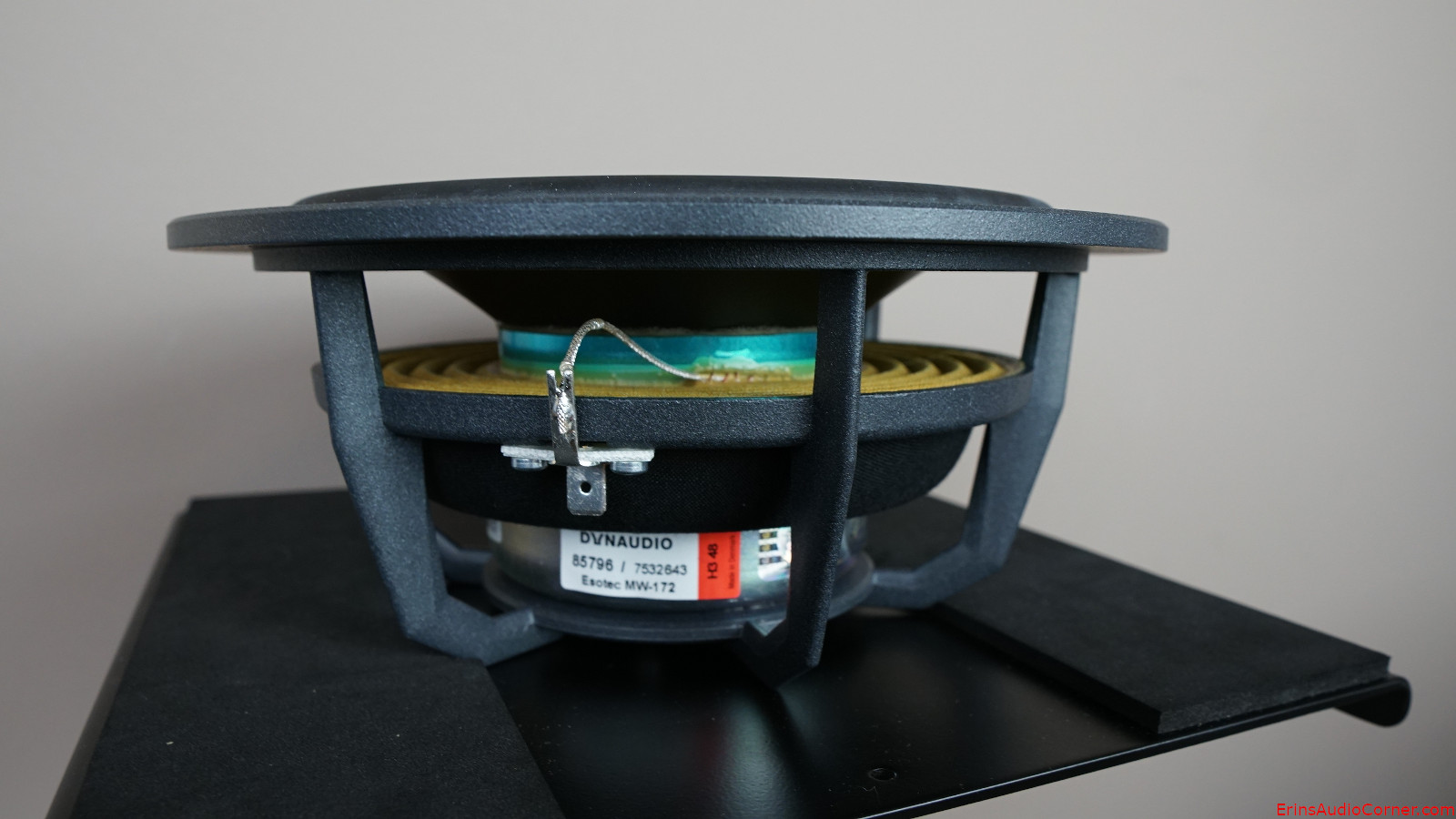
Information
Per the manual:
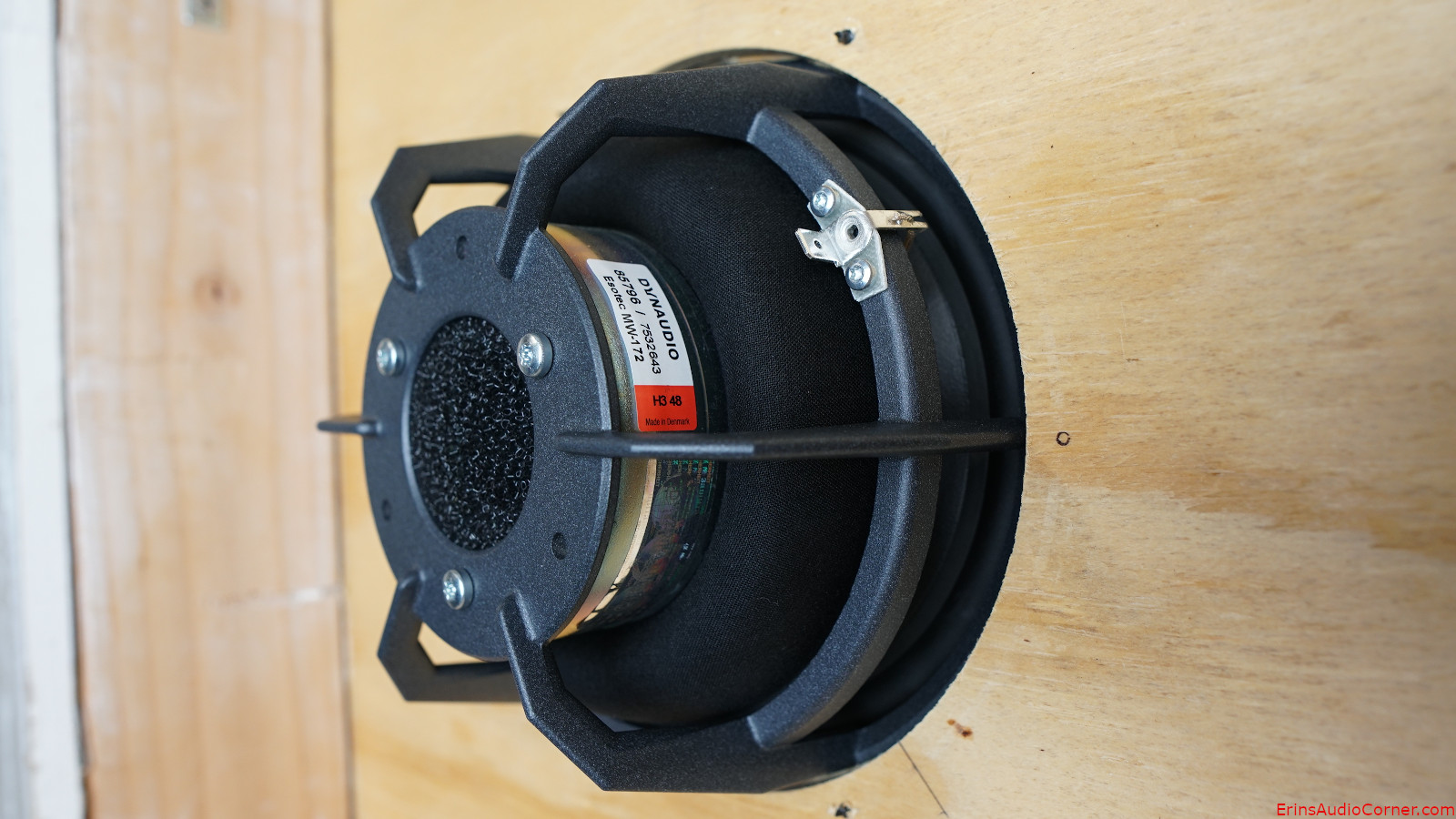
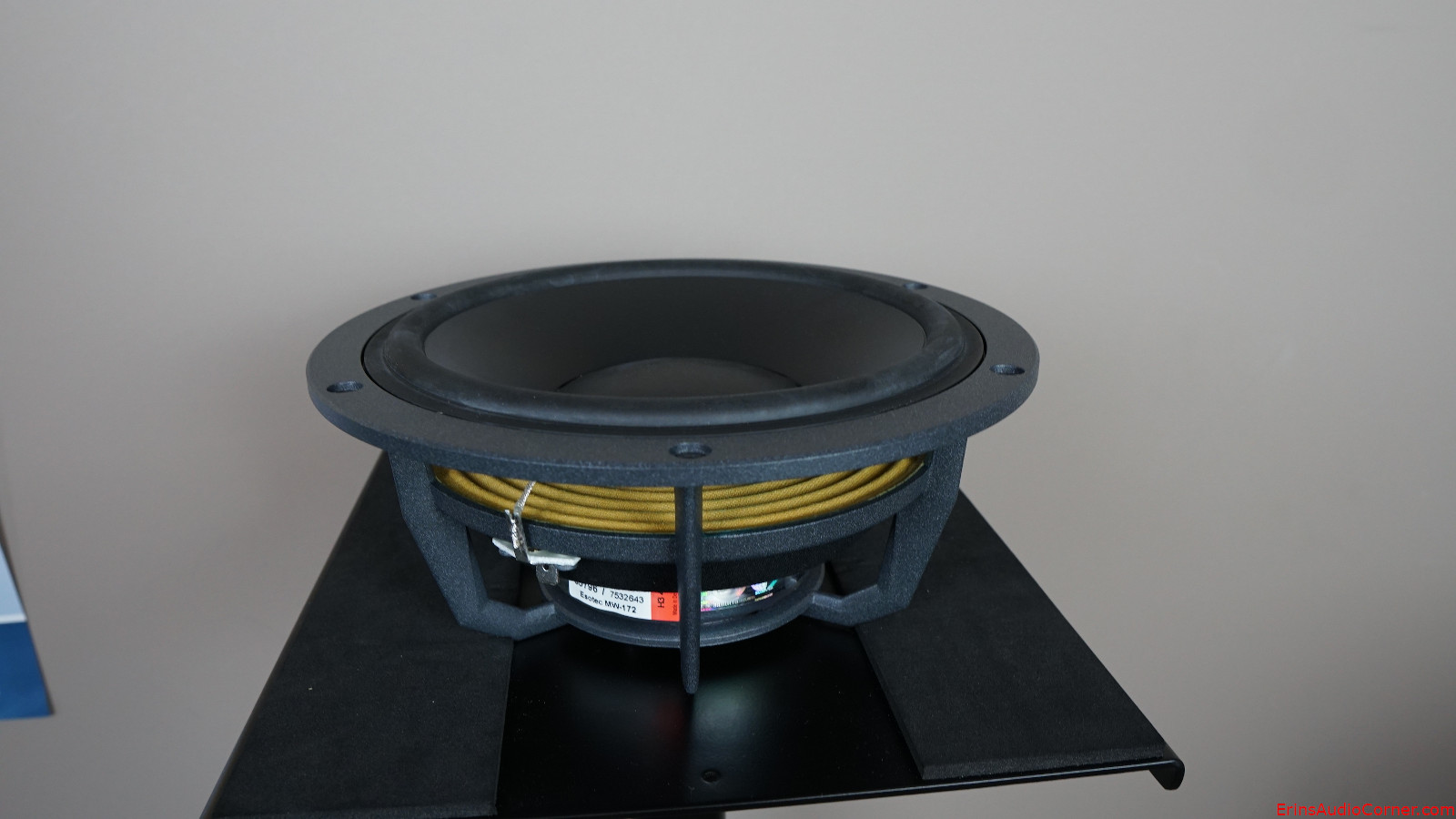
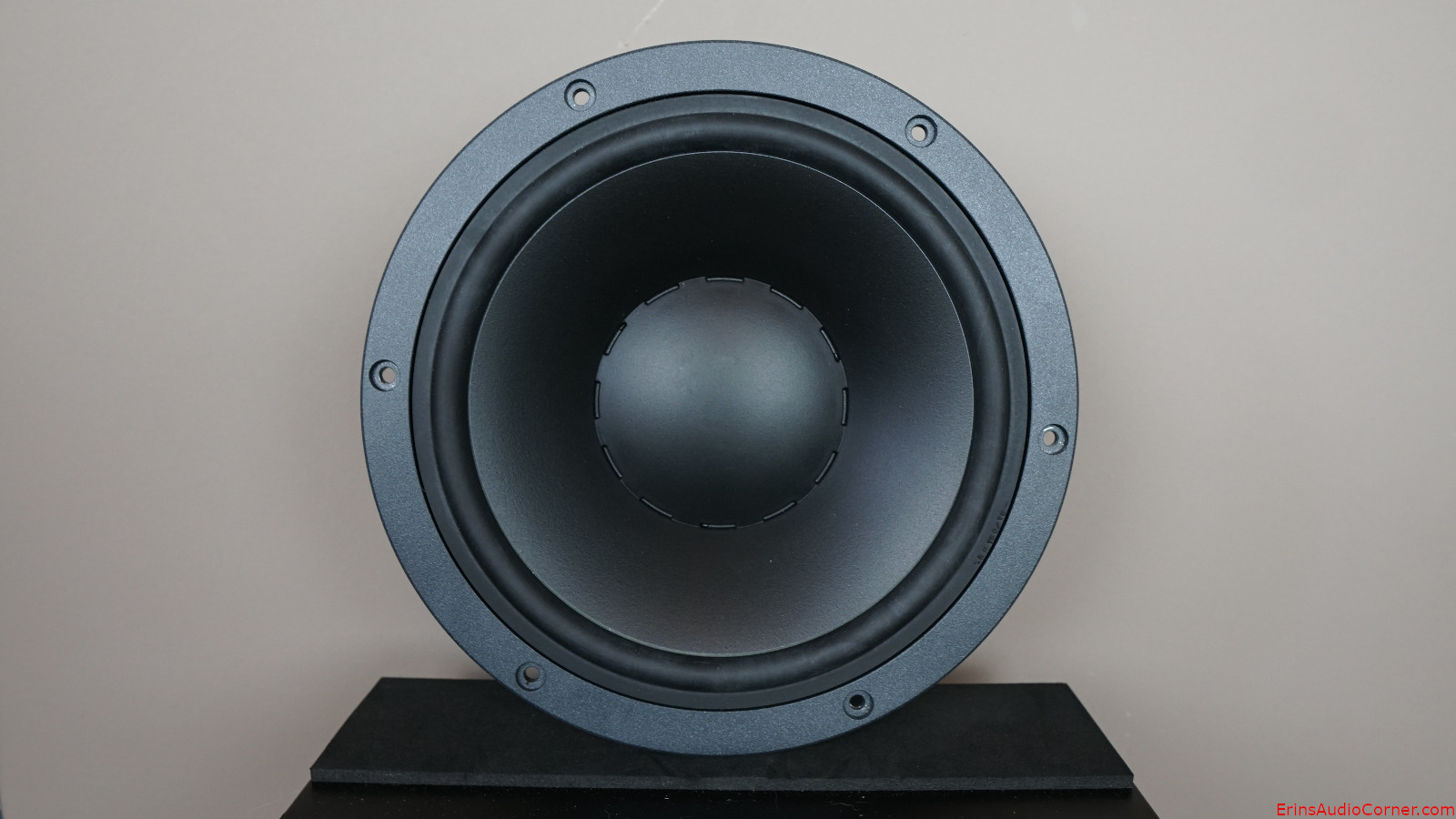
Product Spec Sheet can be found here but I have provided a screen capture of the specs below.
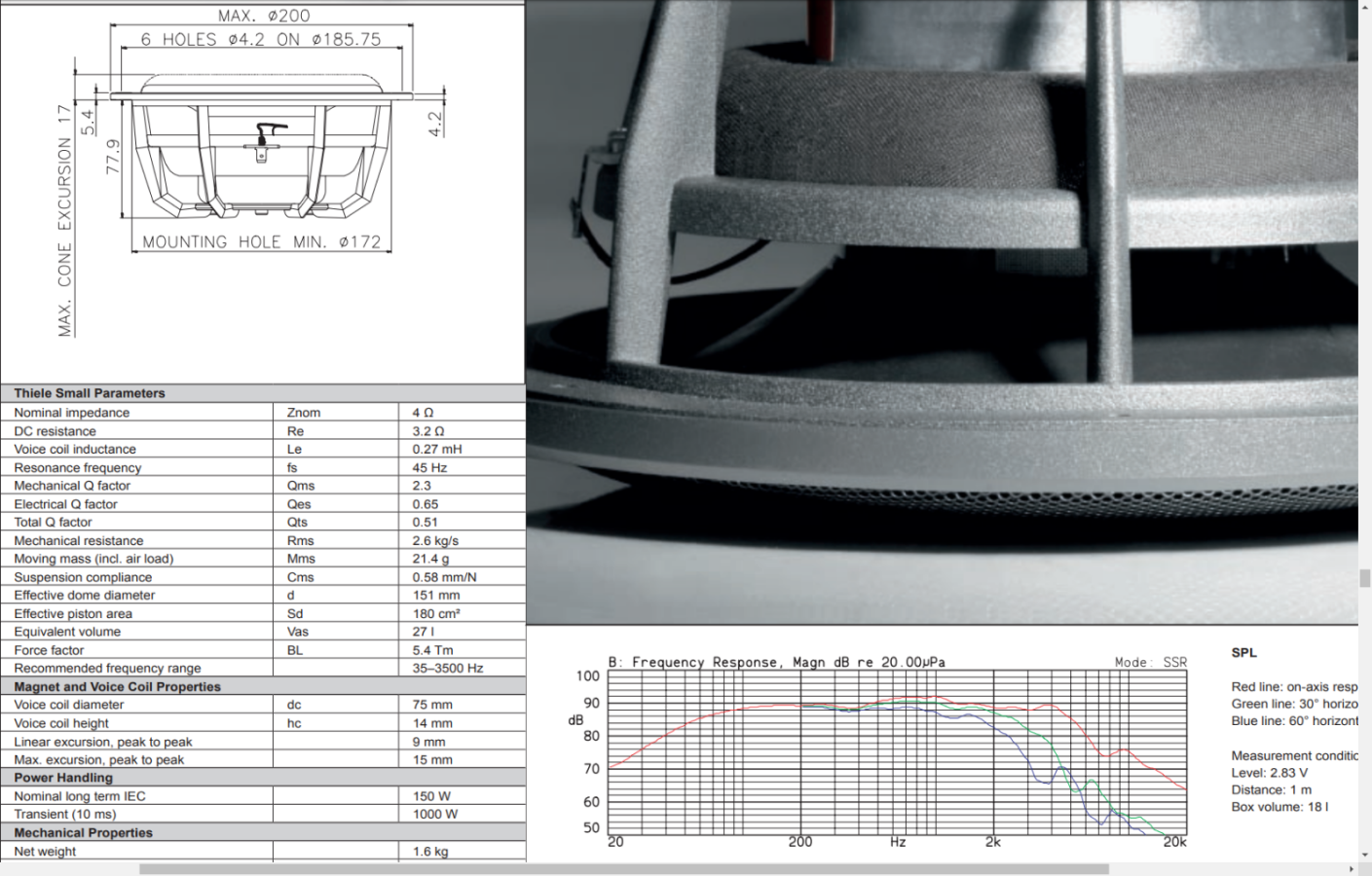
Test Results
Foreword: Subjective Analysis vs Objective Data of Drive Units (click here)
Small Signal Testing (Thiele-Small Results)
Using Klippel’s Distortion Analyzer 2, Linear Lumped Parameter Measurement Module, Pro Driver Stand and provided Panasonic ANR12821 Laser along with Klippel’s Training 1 - Linear Lumped Parameter Measurement tutorial, I measured this drive unit’s impedance and small-signal parameters. Below are the results.
Note: The impedance graph can be found in the Frequency Response Linearity graphic later in this review.
Large Signal Modeling (Linear Xmax Results)
Using Klippel’s Distortion Analyzer 2, Large Signal Identification Module, Pro Driver Stand and provided Panasonic ANR12821 Laser along with Klippel’s Training 3 - Loudspeaker Nonlinearities tutorial, I measured the linear, nonlinear and thermal parameters of this drive unit.
Nonlinearities
This drive unit’s linear excursion is measured at 3.3mm, due to exceeding the Bl distortion limit of 82% for the total harmonic distortion limit of 10%.
The displacement limits XBL, XC, XL and Xd describe the limiting effect for the force factor Bl(x), compliance Cms(x), inductance Le(x) and Doppler effect, respectively, according to the threshold values Blmin, Cmin, Zmax and d2 used. The thresholds Blmin= 82 %, Cmin=75 %, Zmax=10 % and d2=10% generate for a two-tone-signal (f1=fs, f2=8.5fs) 10 % total harmonic distortion and 10 % intermodulation distortion. The thresholds Blmin= 70 %, Cmin=50 %, Zmax=17 % create 20 % total harmonic distortion which is becoming the standard for acceptable subwoofer distortion thresholds. Traditionally, Xmax has been defined as the physical overhang of the voice coil, 15% times the physical overhang, or the point where BL has dropped 70% from its X=0 value (same as X Bl). The additional nonlinear limits allow us to quantify the other factors that limit a loudspeaker’s performance.
These parameters are defined in more detail in the (Klippel) papers:
We can break the above information down further. The below text is written by Patrick Turnmire of Red Rock Acoustics and used with his permission, substituting data from this drive unit’s test results where applicable.
Large Signal Modeling
At higher amplitudes, loudspeakers produce substantial distortion in the output signal, generated by nonlinear ties inherent in the transducer. The dominant nonlinear distortions are predictable and are closely related with the general principle, particular design, material properties and assembling techniques of the loudspeaker. The Klippel Distortion Analyzer combines nonlinear measurement techniques with computer simulation to explain the generation of the nonlinear distortions, to identify their physical causes and to give suggestion for constructional improvements. Better insight into the nonlinear mechanisms makes it possible to further optimize the transducer in respect with sound quality, weight, size and cost.
Nonlinear Characteristics
The dominant nonlinearities are modelled by variable parameters such as
Bl(x)instantaneous electro-dynamic coupling factor (force factor of the motor) defined by the integral of the magnetic flux density B over voice coil length l as a function of displacementKMS(x)mechanical stiffness of driver suspension a function of displacementLE(i)voice coil inductance as a function of input current (describes nonlinear permeability of the iron path)LE(x)voice coil inductance as a function of displacement
Nonlinear Parameters
Bl change with excursion
.png)
The electrodynamic coupling factor, also called Bl-product or force factor Bl(x), is defined by the integral of the magnetic flux density B over voice coil length l and translates current into force. In traditional modeling this parameter is assumed to be constant. The force factor Bl(0) at the rest position corresponds with the Bl-product used in linear modeling. The red curve displays Bl over the entire displacement range covered during the measurement. You see the typical decay of Bl when the voice coil moves out of the gap. At the end of the measurement, the black curve shows the confidential range (interval where the voice coil displacement in this range occurred 99% of the measurement time). During the measurement, the black curve shows the current working range. The dashed curve displays Bl(x) mirrored at the rest position of the voice coil – this way, asymmetries can be quickly identified. Since a laser was connected during the measurement, a coil in / coil out marker is displayed on the bottom left / bottom right.
Suspension Stiffness change with excursion
.png)
The stiffness KMS(x) describes the mechanical properties of the suspension. Its inverse is the compliance CMS(x).
Inductance change with excursion
.png)
.png)
The inductance components Le (x) and Bl(i) of most drivers have a strong asymmetric characteristic. If the voice coil moves towards the back plate the inductance usually increases since the magnetic field generated by the current in the voice coil has a lower magnetic resistance due to the shorter air path. The nonlinear inductance Le(x) has two nonlinear effects. First the variation of the electrical impedance with voice coil displacement x affects the input current of the driver. Here the nonlinear source of distortion is the multiplication of displacement and current. The second effect is the generation of a reluctance force which may be interpreted as an electromagnetic motor force proportional to the squared input current.
The flux modulation Bl(i) has two effects too. On the electrical side the back EMF Bl(i)*v produces nonlinear distortion due to the multiplication of current i and velocity v. On the mechanical side the driving force F = Bl(i)*i comprises a nonlinear term due to the squared current i. This force produces similar effects as the variable term Le(x).
Fs shift with excursion
.png)
Qts change with excursion
.png)
Asymmetrical Nonlinearities
Asymmetrical nonlinearities produce not only second- and higher-order distortions but also a dc-part in the displacement by rectifying low frequency components. For an asymmetric stiffness characteristic the dc-components moves the voice coil for any excitation signal in the direction of the stiffness minimum. For an asymmetric force factor characteristic the dc-component depends on the frequency of the excitation signal. A sinusoidal tone below resonance (f<fS) would generate or force moving the voice coil always in the force factor maximum. This effect is most welcome for stabilizing voice coil position. However, above the resonance frequency (f>fS) would generate a dc-component moving the voice coil in the force factor minimum and may cause severe stability problems. For an asymmetric inductance characteristic the dc-component moves the voice coil for any excitation signal in the direction of the inductance maximum. Please note that the dynamically generated DC-components cause interactions between the driver nonlinearities. An optimal rest position of the coil in the gap may be destroyed by an asymmetric compliance or inductance characteristic at higher amplitudes. The module Large Signal Simulation (SIM) allows systematic investigation of the complicated behavior.
Bl symmetry xb(x)
This curve shows the symmetry point in the nonlinear Bl-curve where a negative and positive displacement x=xpeak will produce the same force factor Bl(xb(x) + x) = Bl(xb(x) – x).
If the shift xb(x) is independent on the displacement amplitude x then the force factor asymmetry is caused by an offset of the voice coil position and can be simply compensated.
If the optimal shift xb(x) varies with the displacement amplitude x then the force factor asymmetry is caused by an asymmetrical geometry of the magnetic field and cannot completely be compensated by coil shifting.
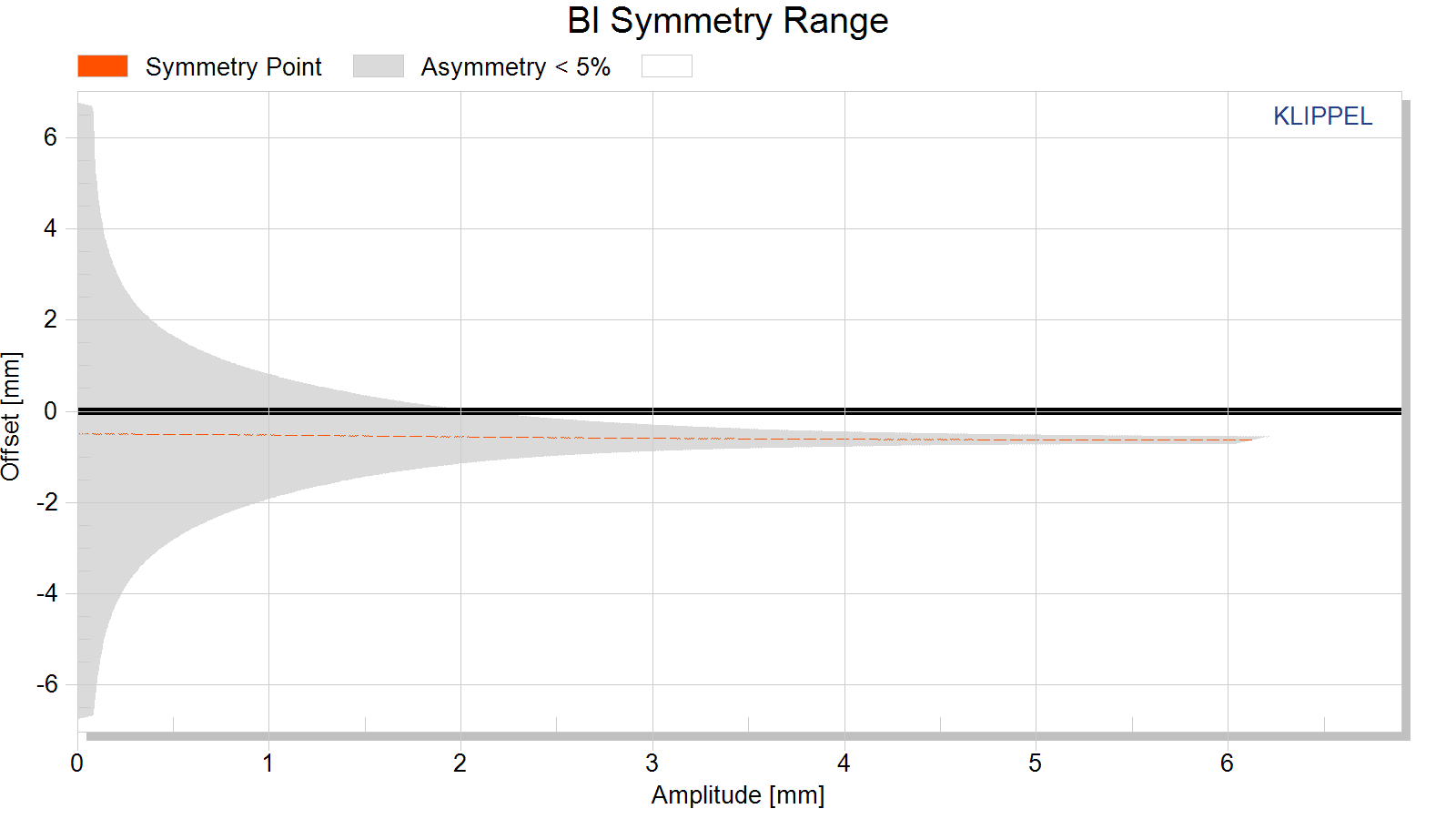
Kms Symmetry xc(x)
This curve shows the symmetry point in the nonlinear compliance curve where a negative and positive displacement x=xpeak will produce the same compliance value kms(xc(x) + x) = kms(xc(x) – x).
A high value of the symmetry point xc(x) at small displacement amplitudes x » 0 indicates that the rest position does not agree with the minimum of the stiffness characteristic. This may be caused by an asymmetry in the geometry of the spider (cup form) or surround (half wave). A high value of the symmetry point xc(x) at maximal displacement x» xmax may be caused by asymmetric limiting of the surround.
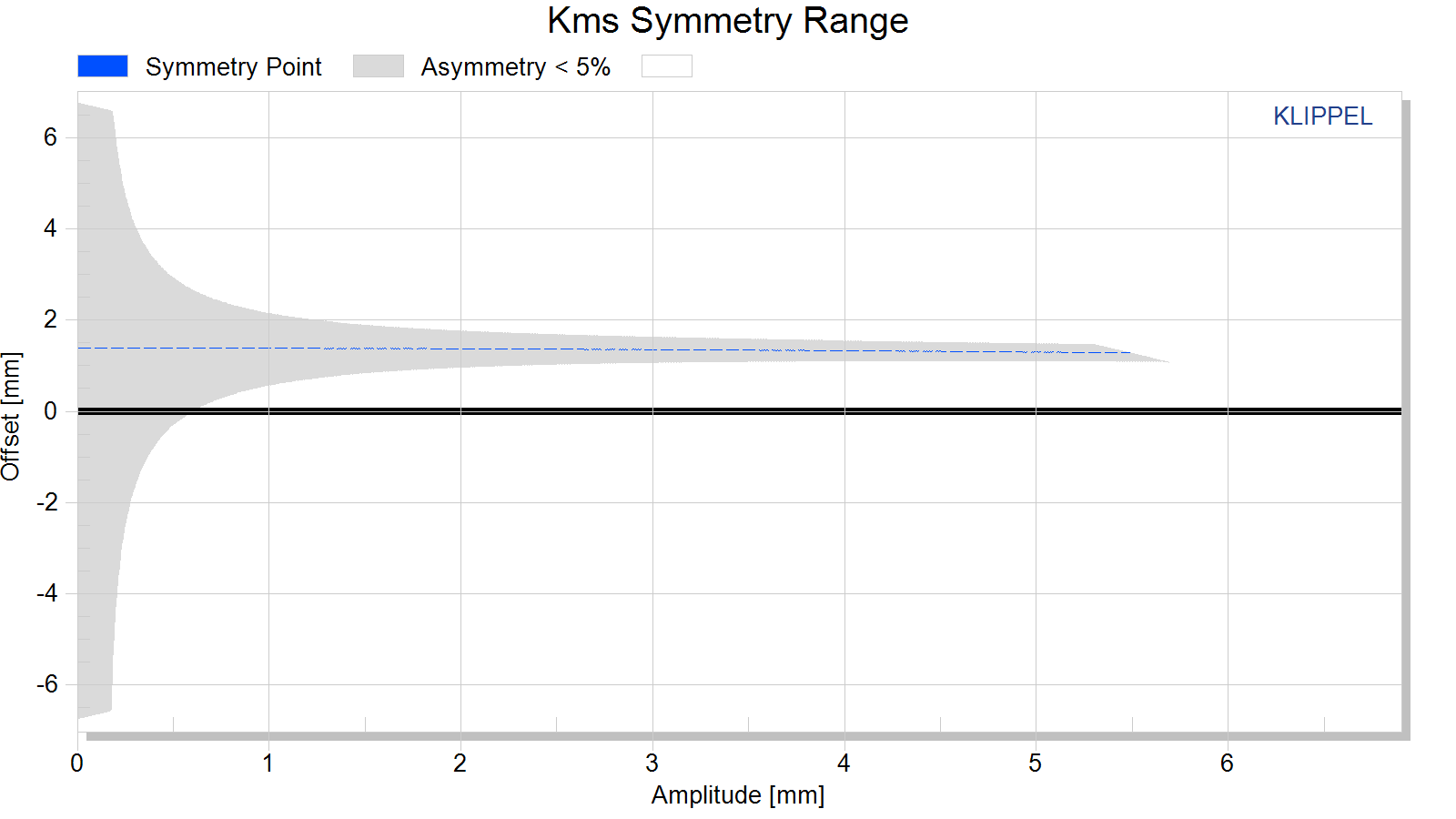
Parameters at the Rest Position
For accurate system modelling “Large + Cold” parameters are preferable to “Small Signal” parameters because they more closely reflect the parameters in their typical operating range.
Frequency Response
Frequency Response data is generated using Klippel’s Transfer Function Mueasurement module in conjunction with Klippel’s In-Situ Compensation module. This pairing enables me to generate anechoic-quality measurements in the farfield with a resolution of response down to 20Hz increments; far better than splicing nearfield with gated farfield data (the latter of which is often limited to 200Hz or 300Hz resolution and will not show high-Q resonance in the midrange and bass frequencies). Data is represented at 2.83v/1m.
On-Axis Linearity and Impedance
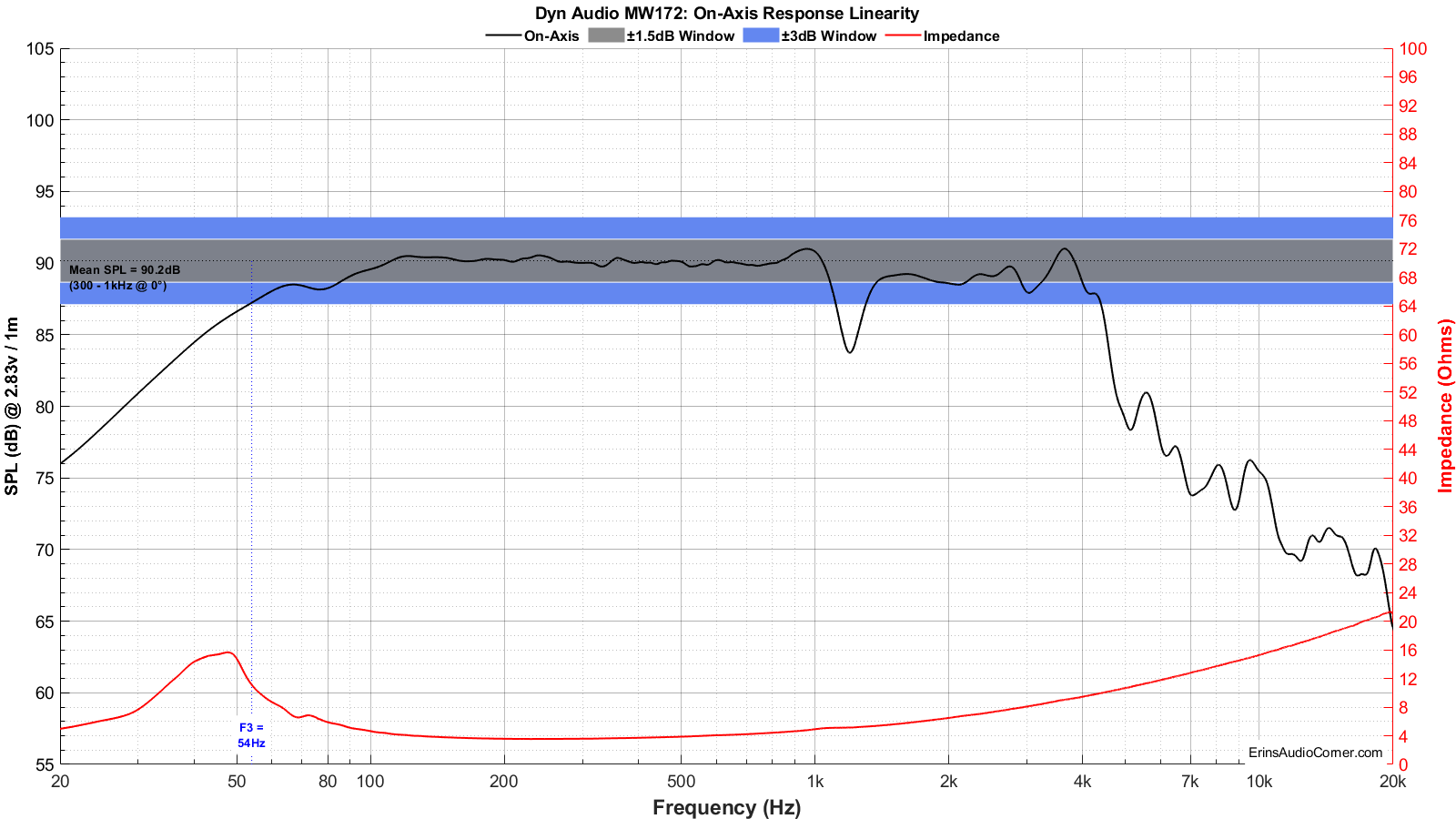
On and Off-Axis Frequency Response
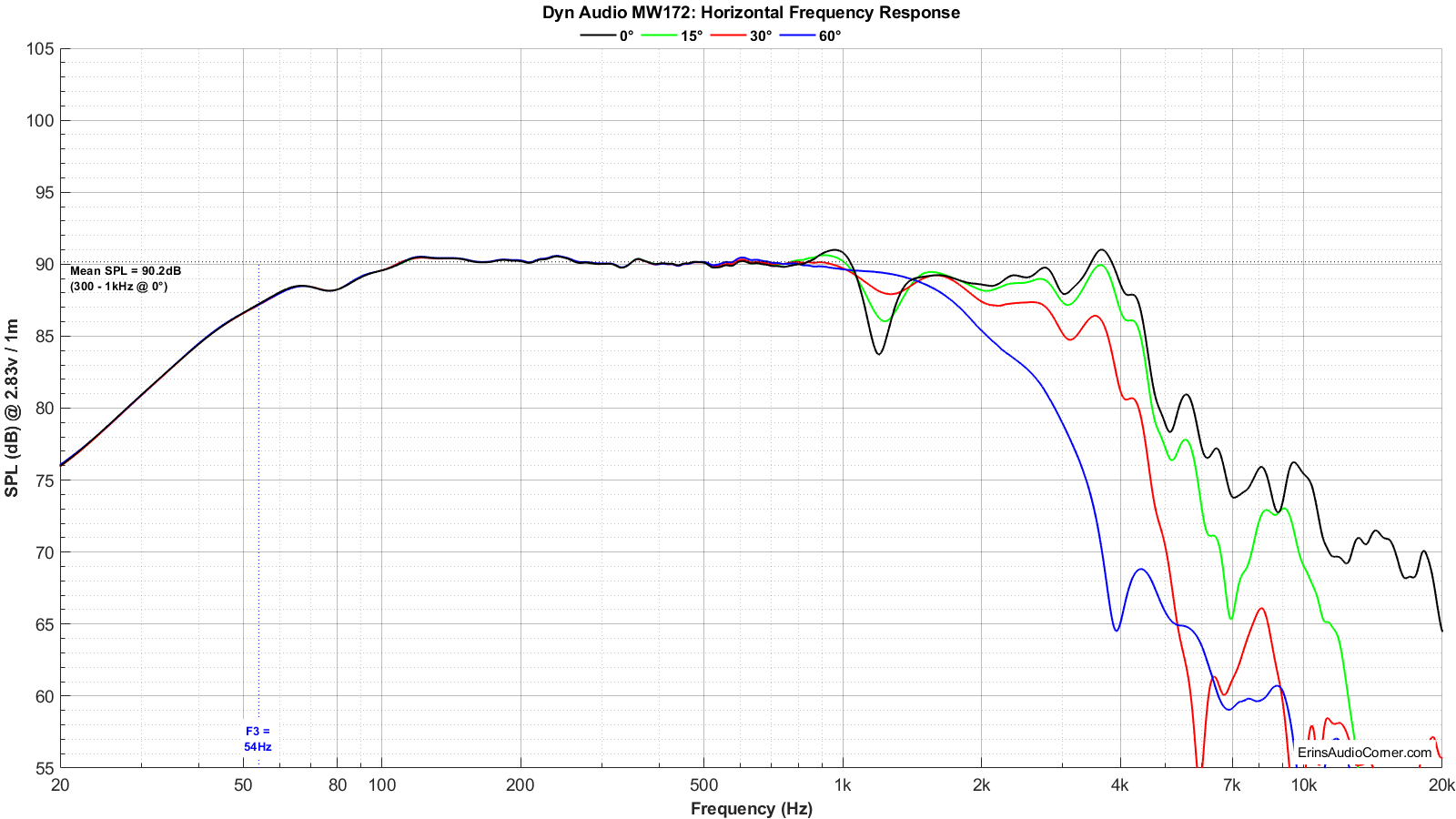
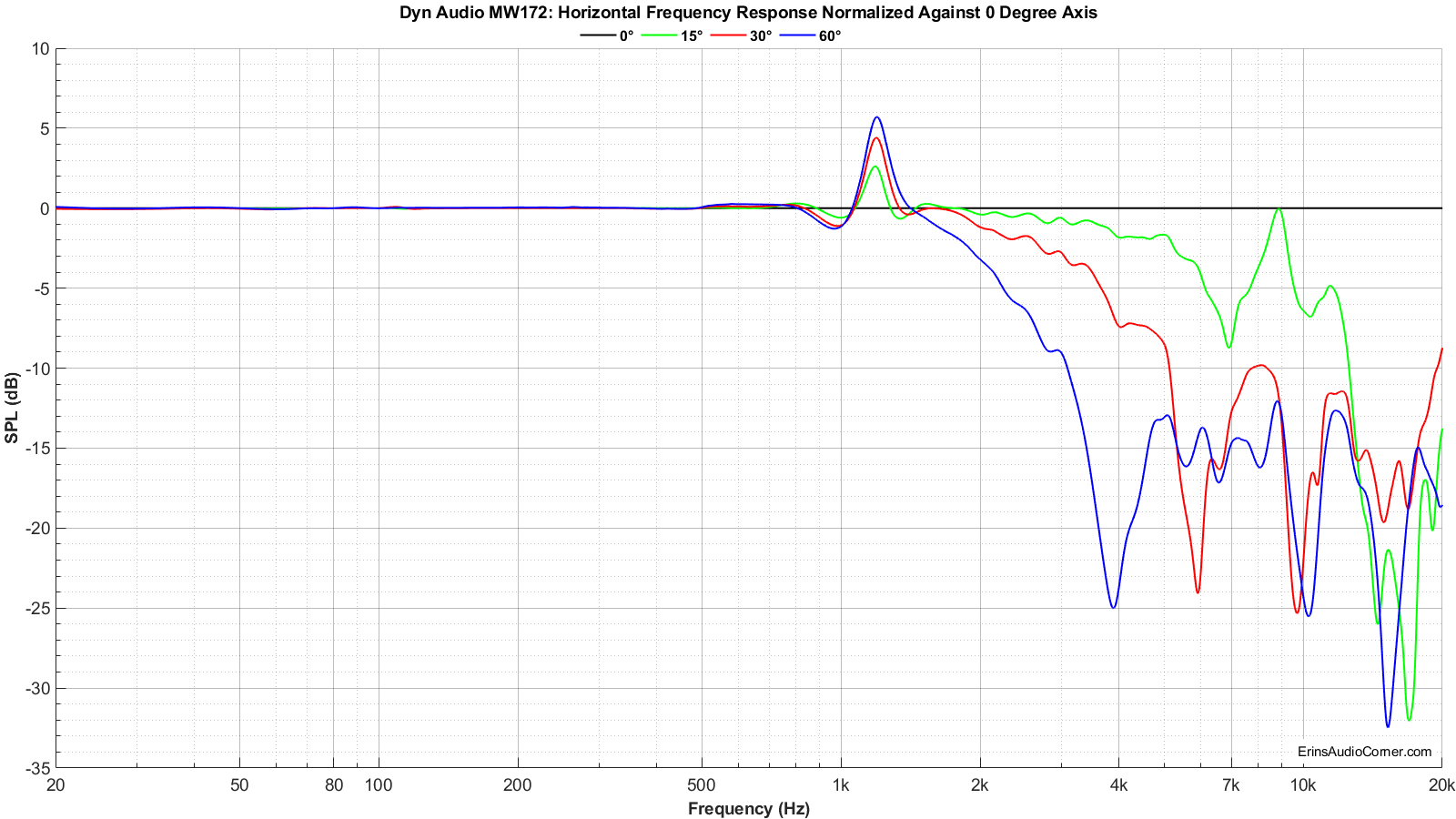
Total Harmonic Distortion (THD) and Compression:
Klippel’s 3D-DISTORTION MEASUREMENT (DIS) module is used to calculate the Total Harmonic Distortion and Compression for this drive unit.
Distortion and Compression measurements were completed in the nearfield (approximately 0.3 meters). However, SPL provided is relative to 1 meter distance.
Harmonic Distortion and Compression: What does this data mean? (click me for info)
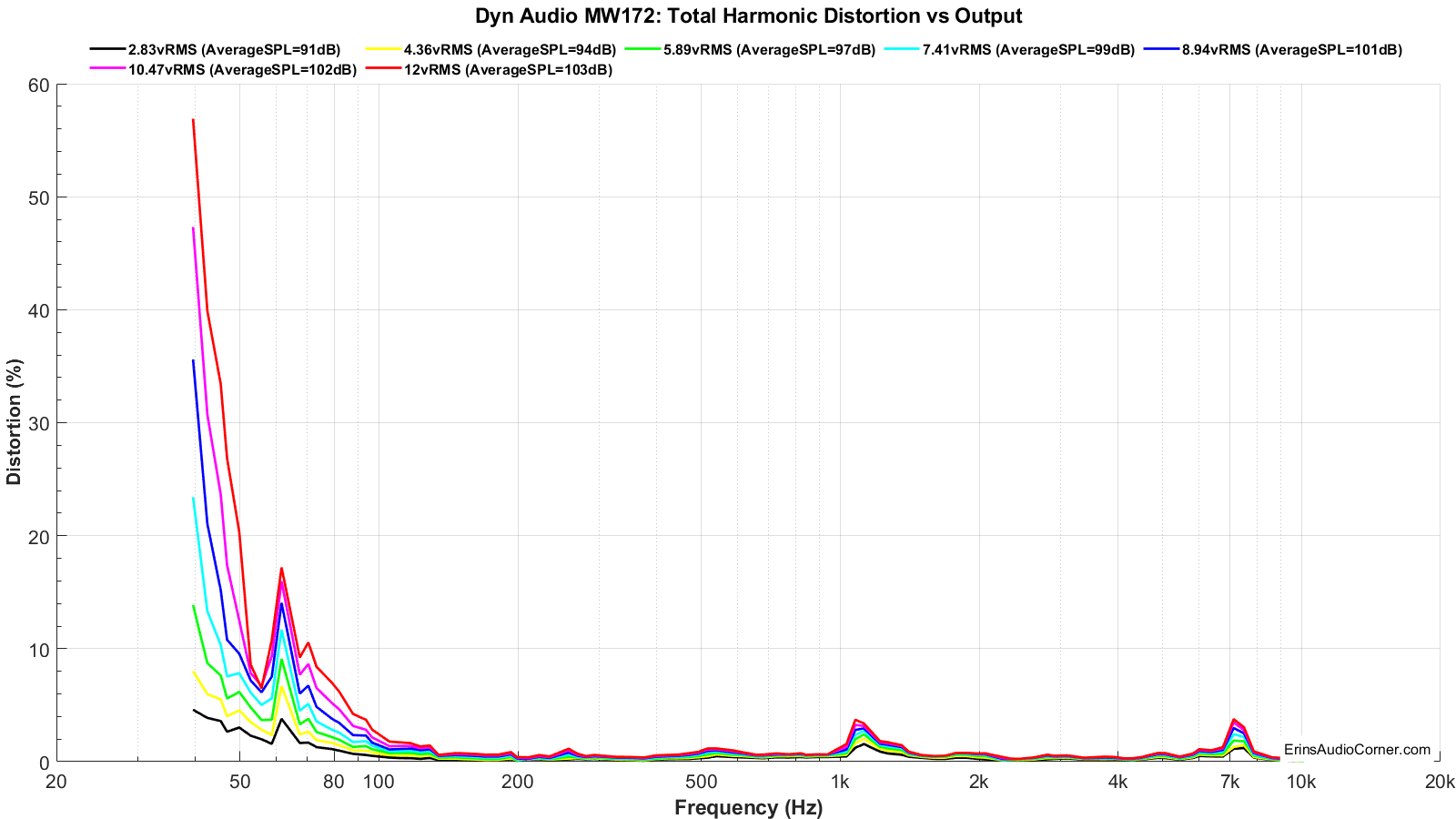
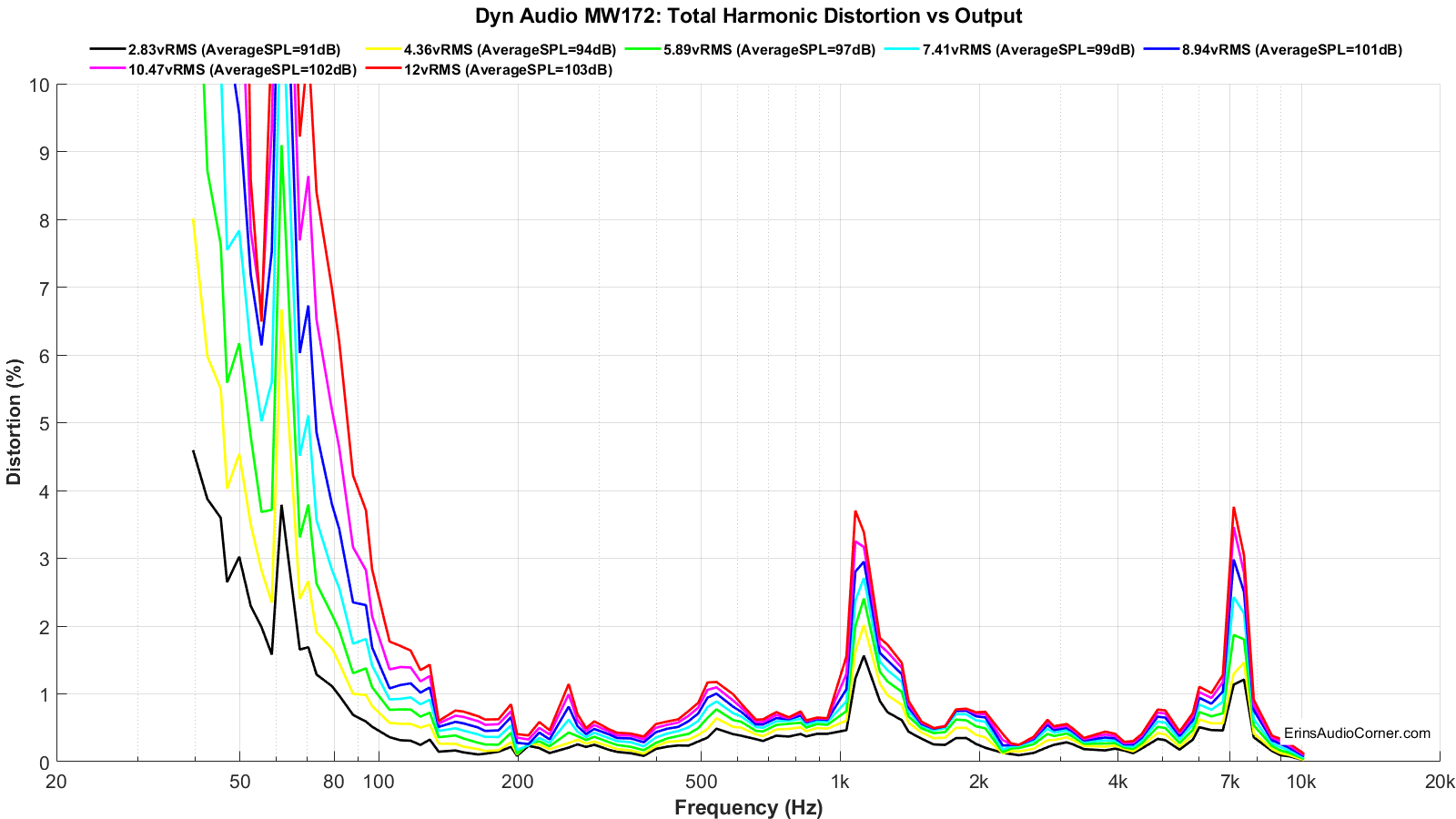

Maximum Long Term SPL (Multitone Distortion Testing)
Klippel’s Multi-Tone Measurement (MTON) module is used to calculate the maximum SPL for this drive unit.
The below data provides the metrics for how Maximum Long Term SPL is determined. This measurement follows the IEC 60268-21 Long Term SPL protocol, per Klippel’s template, as such:
The thresholds to determine the maximum SPL are:
When the speaker has reached either or both above thresholds, the test is terminated and the SPL of the last test is the maximum SPL. In the below results I provide the summarized table as well as the data showing how/why this SPL was deemed to be the maximum.
This measurement is conducted twice:
You can watch a demonstration of this testing via my YouTube channel:
Test 1: 20Hz to 20kHz
Table Results:
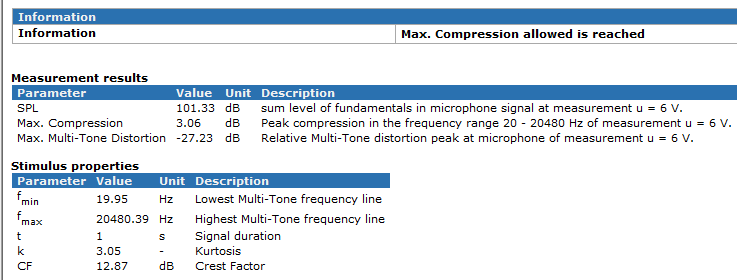
Multitone compression testing. The red line shows the final measurement where either distortion and/or compression failed. The voltage just before this is used to help determine the maximum SPL.

Multitone distortion testing. The dashed blue line represents the -20dB (10% distortion) threshold for failure. The dashed red line is for reference and shows the 1% distortion mark (but has no bearing on pass/fail). The green line shows the final measurement where either distortion and/or compression failed. The voltage just before this is used to help determine the maximum SPL.
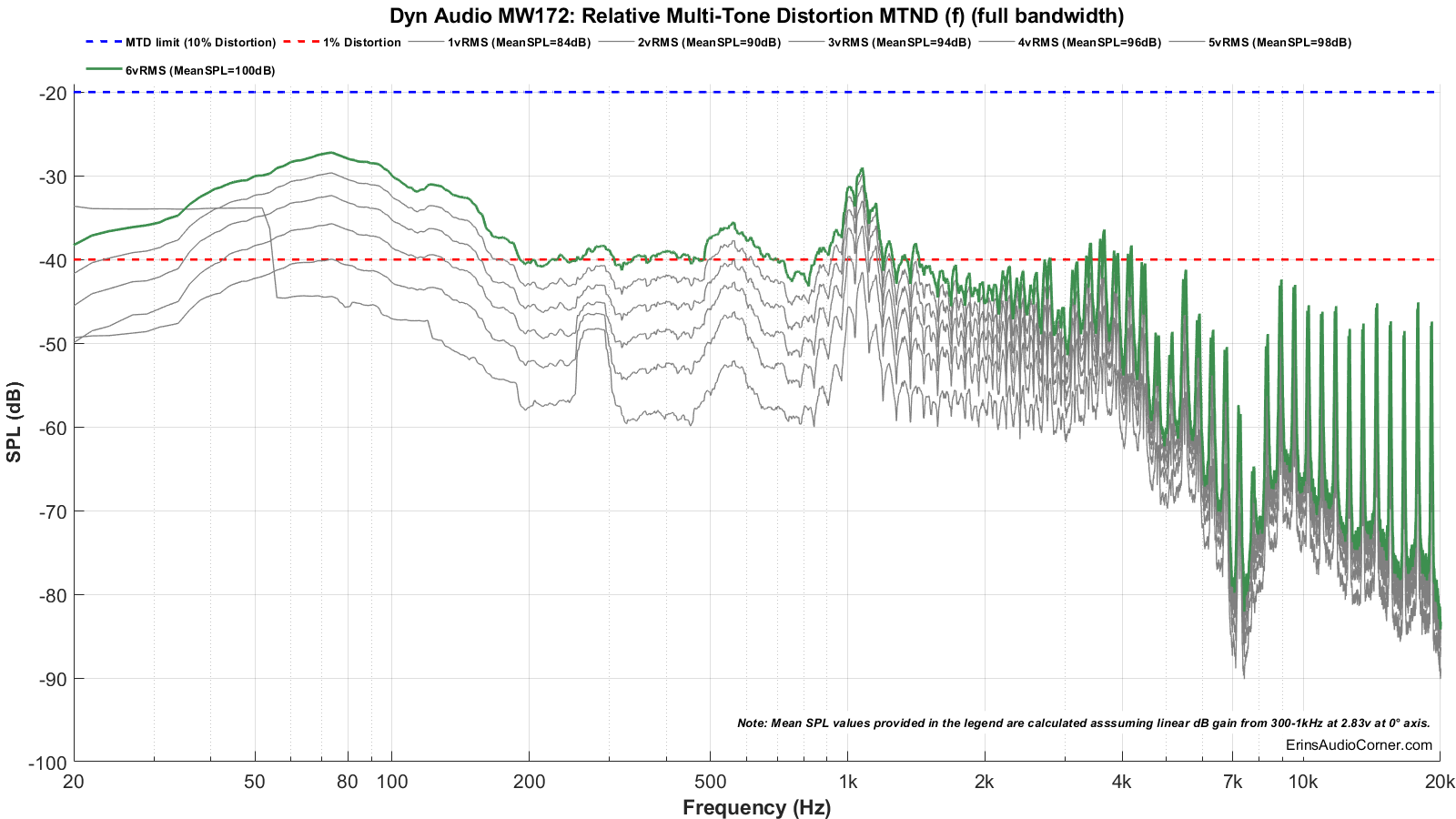
Test 2: 80Hz to 5kHz
Table Results:
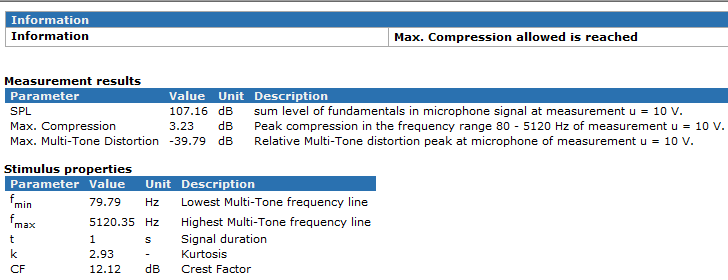
Multitone compression testing. The red line shows the final measurement where either distortion and/or compression failed. The voltage just before this is used to help determine the maximum SPL.
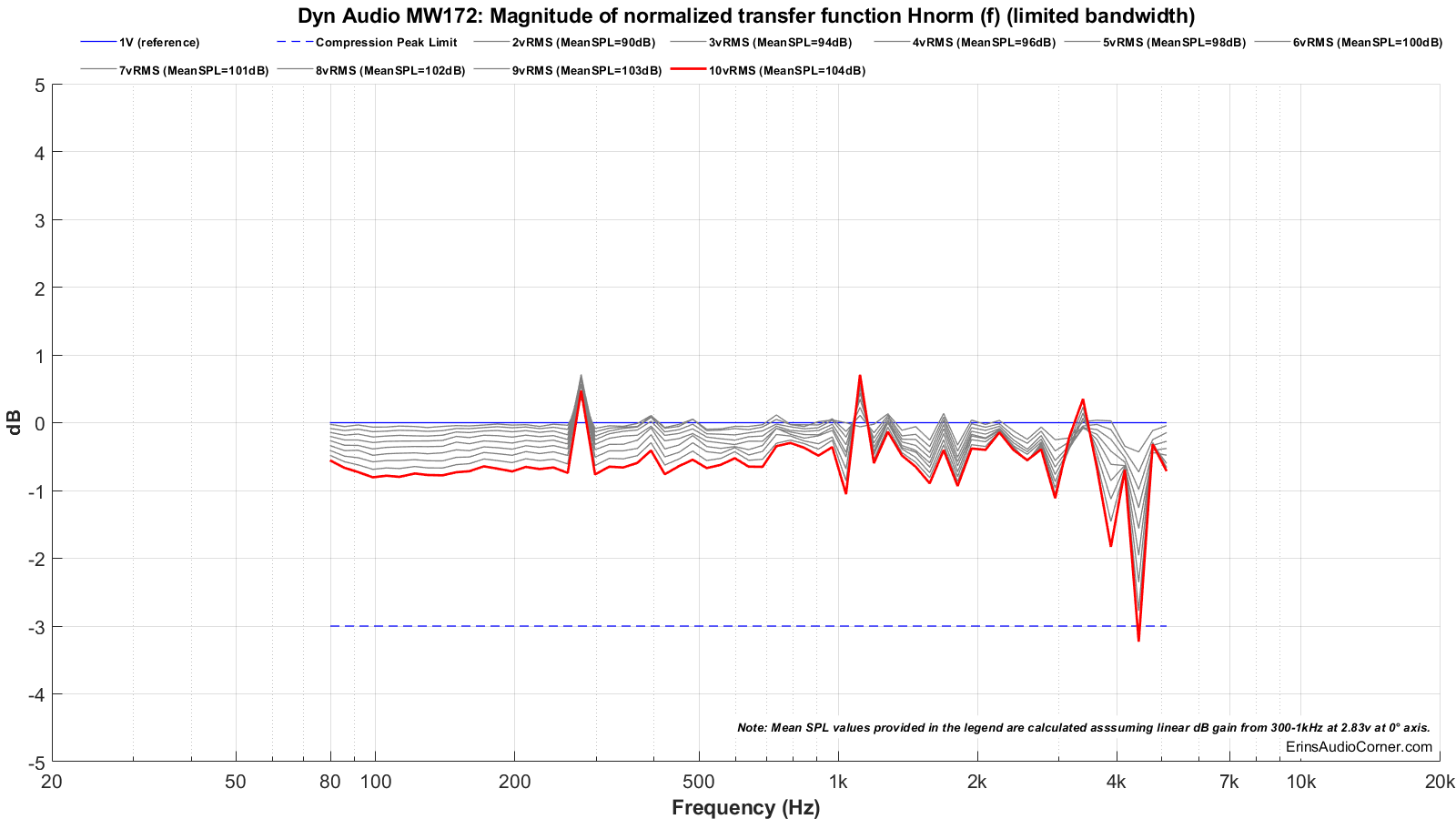
Multitone distortion testing. The dashed blue line represents the -20dB (10% distortion) threshold for failure. The dashed red line is for reference and shows the 1% distortion mark (but has no bearing on pass/fail). The green line shows the final measurement where either distortion and/or compression failed. The voltage just before this is used to help determine the maximum SPL.
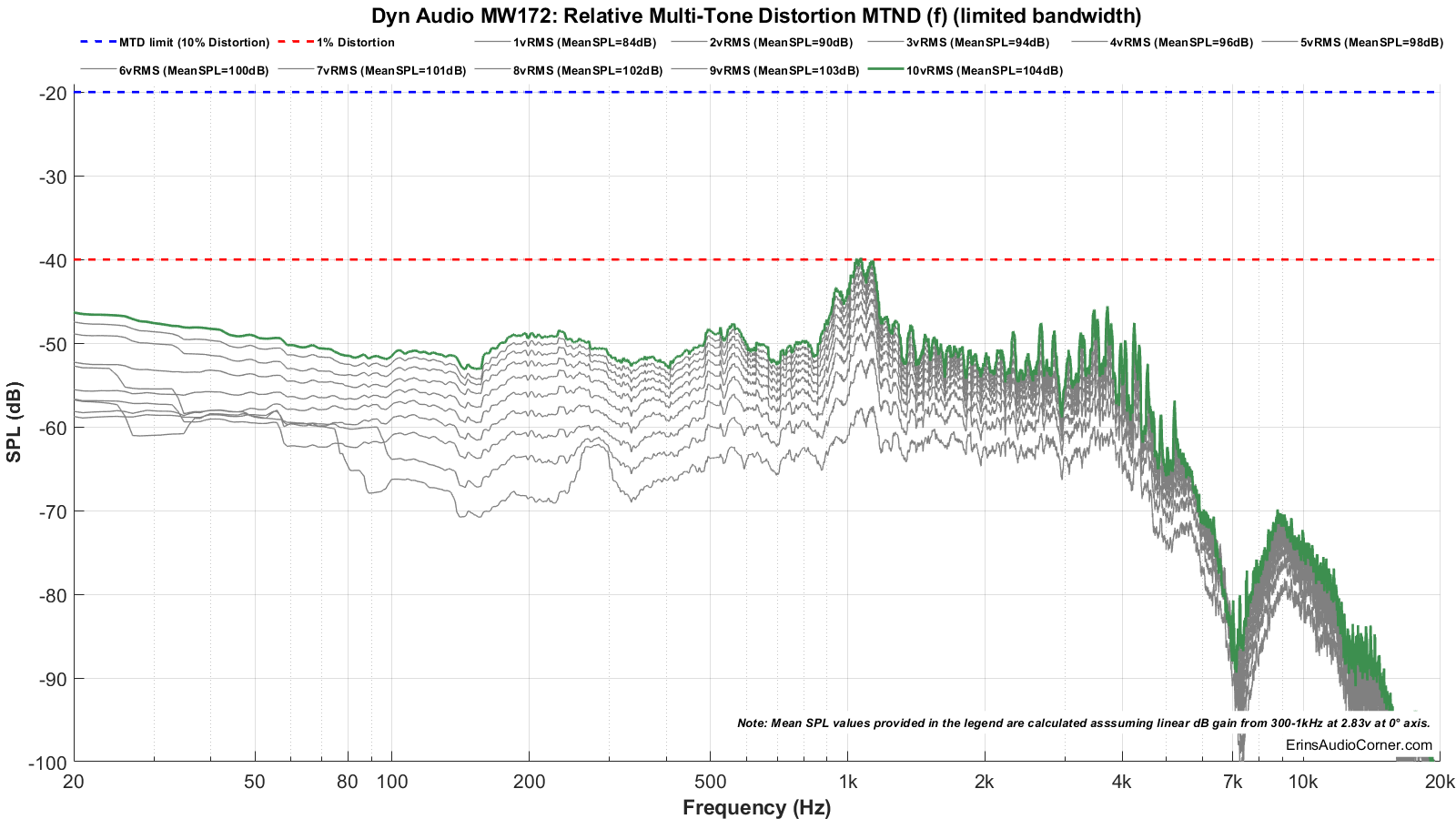
The above data can be summed up by looking at the tables above but is provided here again:
Bottom Line
T/S Parameters and Linear Excursion:
Frequency Response:
Distortion and Compression:
I know many who have used this driver and loved it (or love it as they are still using it). I have never used it myself but I was hoping for better results in regards to the linear excursion because I was thinking of ways to shoehorn this in to my car’s doors. While the Dyn spec itself indicates not to expect much, with their stated 4.5mm one-way linear excursion, I was hoping maybe they were just being cautious with the number. Unfortunately, my results show even lower linear excursion than the already low value stated in the spec. Obviously, using this with a proper high-pass filter will make the low linear excursion less of an issue but you don’t have a lot of room to play around here. 80Hz is always a good starting point in car audio for midbass; adjust from there to your own needs and liking. Above this, however, the response is quite linear until the 1kHz region where issues start to propogate. The linearity between the 100-1kHz region is excellent so as long as you cross it properly as a midbass I think you can get some fine performance. Just don’t expect to cross it too low and get earth-shattering bass.
And, as always, how you use the speaker and what you need it to do will determine what works best for you. If you aren’t a recovering basshead and listen only at mild volumes (say, in the 80-85dB range) then crossing over at 60Hz is more feasible than if you are the kind of person who wants to wail on bass heavy music at 95dB. As they say, YMMV (your mileage may vary). Use the data as a guide to make an informed decision.
Contribute
If you like what you see here and want to help me keep it going, you can donate via PayPal at this link. If you can help by chipping in, I would truly appreciate it.
You can also join my Facebook and YouTube pages if you’d like to follow along with updates.
https://www.erinsaudiocorner.com/driveunits/dyn_mw172/
For those who would rather watch a video review, I plan to publish a review via YouTube tomorrow on my channel. So keep an eye out for that.
Cheers!
Dyn Audio MW172 Drive Unit Review
- Saturday, Aug 8, 2020

Information
Per the manual:
The new Esotec MW 172 is a 20 cm (8 inch) diameter mid/woofer designed for high performance two-and three way systems.
Retail price is about $600/pair.


Product Spec Sheet can be found here but I have provided a screen capture of the specs below.

Test Results
Foreword: Subjective Analysis vs Objective Data of Drive Units (click here)
Small Signal Testing (Thiele-Small Results)
Using Klippel’s Distortion Analyzer 2, Linear Lumped Parameter Measurement Module, Pro Driver Stand and provided Panasonic ANR12821 Laser along with Klippel’s Training 1 - Linear Lumped Parameter Measurement tutorial, I measured this drive unit’s impedance and small-signal parameters. Below are the results.
Note: The impedance graph can be found in the Frequency Response Linearity graphic later in this review.
Large Signal Modeling (Linear Xmax Results)
Using Klippel’s Distortion Analyzer 2, Large Signal Identification Module, Pro Driver Stand and provided Panasonic ANR12821 Laser along with Klippel’s Training 3 - Loudspeaker Nonlinearities tutorial, I measured the linear, nonlinear and thermal parameters of this drive unit.
Nonlinearities
Code:
X Bl @ Bl min=82% 3.3 mm Displacement limit due to force factor variation
X C @ C min=75% 3.4 mm Displacement limit due to compliance variation
X L @ Z max=10 % >5.8 mm Displacement limit due to inductance variation
X d @ d2=10% 22.3 mm Displacement limit due to IM distortion (Doppler)
Asymmetry (IEC 62458)
Ak 33.90 % Stiffness asymmetry Ak(Xpeak)
Xsym -0.64 mm Symmetry point of Bl(x) at maximal excursionThis drive unit’s linear excursion is measured at 3.3mm, due to exceeding the Bl distortion limit of 82% for the total harmonic distortion limit of 10%.
The displacement limits XBL, XC, XL and Xd describe the limiting effect for the force factor Bl(x), compliance Cms(x), inductance Le(x) and Doppler effect, respectively, according to the threshold values Blmin, Cmin, Zmax and d2 used. The thresholds Blmin= 82 %, Cmin=75 %, Zmax=10 % and d2=10% generate for a two-tone-signal (f1=fs, f2=8.5fs) 10 % total harmonic distortion and 10 % intermodulation distortion. The thresholds Blmin= 70 %, Cmin=50 %, Zmax=17 % create 20 % total harmonic distortion which is becoming the standard for acceptable subwoofer distortion thresholds. Traditionally, Xmax has been defined as the physical overhang of the voice coil, 15% times the physical overhang, or the point where BL has dropped 70% from its X=0 value (same as X Bl). The additional nonlinear limits allow us to quantify the other factors that limit a loudspeaker’s performance.
These parameters are defined in more detail in the (Klippel) papers:
- “AN04 – Measurement of Peak Displacement Xmax”
- “AN05 - Displacement Limits due to Driver Nonlinearities”
- “AN17 - Credibility of Nonlinear Parameters”
- “Prediction of Speaker Performance at High Amplitudes”
- “Assessment of Voice Coil Peak Displacement Xmax”
- “Assessing Large Signal Performance of Loudspeakers”
We can break the above information down further. The below text is written by Patrick Turnmire of Red Rock Acoustics and used with his permission, substituting data from this drive unit’s test results where applicable.
Large Signal Modeling
At higher amplitudes, loudspeakers produce substantial distortion in the output signal, generated by nonlinear ties inherent in the transducer. The dominant nonlinear distortions are predictable and are closely related with the general principle, particular design, material properties and assembling techniques of the loudspeaker. The Klippel Distortion Analyzer combines nonlinear measurement techniques with computer simulation to explain the generation of the nonlinear distortions, to identify their physical causes and to give suggestion for constructional improvements. Better insight into the nonlinear mechanisms makes it possible to further optimize the transducer in respect with sound quality, weight, size and cost.
Nonlinear Characteristics
The dominant nonlinearities are modelled by variable parameters such as
Bl(x)instantaneous electro-dynamic coupling factor (force factor of the motor) defined by the integral of the magnetic flux density B over voice coil length l as a function of displacementKMS(x)mechanical stiffness of driver suspension a function of displacementLE(i)voice coil inductance as a function of input current (describes nonlinear permeability of the iron path)LE(x)voice coil inductance as a function of displacement
Nonlinear Parameters
Bl change with excursion
.png)
The electrodynamic coupling factor, also called Bl-product or force factor Bl(x), is defined by the integral of the magnetic flux density B over voice coil length l and translates current into force. In traditional modeling this parameter is assumed to be constant. The force factor Bl(0) at the rest position corresponds with the Bl-product used in linear modeling. The red curve displays Bl over the entire displacement range covered during the measurement. You see the typical decay of Bl when the voice coil moves out of the gap. At the end of the measurement, the black curve shows the confidential range (interval where the voice coil displacement in this range occurred 99% of the measurement time). During the measurement, the black curve shows the current working range. The dashed curve displays Bl(x) mirrored at the rest position of the voice coil – this way, asymmetries can be quickly identified. Since a laser was connected during the measurement, a coil in / coil out marker is displayed on the bottom left / bottom right.
Suspension Stiffness change with excursion
.png)
The stiffness KMS(x) describes the mechanical properties of the suspension. Its inverse is the compliance CMS(x).
Inductance change with excursion
.png)
.png)
The inductance components Le (x) and Bl(i) of most drivers have a strong asymmetric characteristic. If the voice coil moves towards the back plate the inductance usually increases since the magnetic field generated by the current in the voice coil has a lower magnetic resistance due to the shorter air path. The nonlinear inductance Le(x) has two nonlinear effects. First the variation of the electrical impedance with voice coil displacement x affects the input current of the driver. Here the nonlinear source of distortion is the multiplication of displacement and current. The second effect is the generation of a reluctance force which may be interpreted as an electromagnetic motor force proportional to the squared input current.
The flux modulation Bl(i) has two effects too. On the electrical side the back EMF Bl(i)*v produces nonlinear distortion due to the multiplication of current i and velocity v. On the mechanical side the driving force F = Bl(i)*i comprises a nonlinear term due to the squared current i. This force produces similar effects as the variable term Le(x).
Fs shift with excursion
.png)
Qts change with excursion
.png)
Asymmetrical Nonlinearities
Asymmetrical nonlinearities produce not only second- and higher-order distortions but also a dc-part in the displacement by rectifying low frequency components. For an asymmetric stiffness characteristic the dc-components moves the voice coil for any excitation signal in the direction of the stiffness minimum. For an asymmetric force factor characteristic the dc-component depends on the frequency of the excitation signal. A sinusoidal tone below resonance (f<fS) would generate or force moving the voice coil always in the force factor maximum. This effect is most welcome for stabilizing voice coil position. However, above the resonance frequency (f>fS) would generate a dc-component moving the voice coil in the force factor minimum and may cause severe stability problems. For an asymmetric inductance characteristic the dc-component moves the voice coil for any excitation signal in the direction of the inductance maximum. Please note that the dynamically generated DC-components cause interactions between the driver nonlinearities. An optimal rest position of the coil in the gap may be destroyed by an asymmetric compliance or inductance characteristic at higher amplitudes. The module Large Signal Simulation (SIM) allows systematic investigation of the complicated behavior.
Bl symmetry xb(x)
This curve shows the symmetry point in the nonlinear Bl-curve where a negative and positive displacement x=xpeak will produce the same force factor Bl(xb(x) + x) = Bl(xb(x) – x).
If the shift xb(x) is independent on the displacement amplitude x then the force factor asymmetry is caused by an offset of the voice coil position and can be simply compensated.
If the optimal shift xb(x) varies with the displacement amplitude x then the force factor asymmetry is caused by an asymmetrical geometry of the magnetic field and cannot completely be compensated by coil shifting.

Kms Symmetry xc(x)
This curve shows the symmetry point in the nonlinear compliance curve where a negative and positive displacement x=xpeak will produce the same compliance value kms(xc(x) + x) = kms(xc(x) – x).
A high value of the symmetry point xc(x) at small displacement amplitudes x » 0 indicates that the rest position does not agree with the minimum of the stiffness characteristic. This may be caused by an asymmetry in the geometry of the spider (cup form) or surround (half wave). A high value of the symmetry point xc(x) at maximal displacement x» xmax may be caused by asymmetric limiting of the surround.

Parameters at the Rest Position
For accurate system modelling “Large + Cold” parameters are preferable to “Small Signal” parameters because they more closely reflect the parameters in their typical operating range.
Frequency Response
Frequency Response data is generated using Klippel’s Transfer Function Mueasurement module in conjunction with Klippel’s In-Situ Compensation module. This pairing enables me to generate anechoic-quality measurements in the farfield with a resolution of response down to 20Hz increments; far better than splicing nearfield with gated farfield data (the latter of which is often limited to 200Hz or 300Hz resolution and will not show high-Q resonance in the midrange and bass frequencies). Data is represented at 2.83v/1m.
On-Axis Linearity and Impedance

On and Off-Axis Frequency Response


Total Harmonic Distortion (THD) and Compression:
Klippel’s 3D-DISTORTION MEASUREMENT (DIS) module is used to calculate the Total Harmonic Distortion and Compression for this drive unit.
Distortion and Compression measurements were completed in the nearfield (approximately 0.3 meters). However, SPL provided is relative to 1 meter distance.
Harmonic Distortion and Compression: What does this data mean? (click me for info)



Maximum Long Term SPL (Multitone Distortion Testing)
Klippel’s Multi-Tone Measurement (MTON) module is used to calculate the maximum SPL for this drive unit.
The below data provides the metrics for how Maximum Long Term SPL is determined. This measurement follows the IEC 60268-21 Long Term SPL protocol, per Klippel’s template, as such:
- Rated maximum sound pressure according IEC 60268-21 §18.4
- Using broadband multi-tone stimulus according §8.4
- Stimulus time = 60 s Excitation time + Preloops according §18.4.1
The thresholds to determine the maximum SPL are:
- -20dB Distortion relative to the fundamental
- -3dB compression relative to the reference (1V) measurement
When the speaker has reached either or both above thresholds, the test is terminated and the SPL of the last test is the maximum SPL. In the below results I provide the summarized table as well as the data showing how/why this SPL was deemed to be the maximum.
This measurement is conducted twice:
- First with a 20Hz to 20kHz multitone signal
- Second with a limited bandwidth multitone signal
You can watch a demonstration of this testing via my YouTube channel:
Test 1: 20Hz to 20kHz
Table Results:

Multitone compression testing. The red line shows the final measurement where either distortion and/or compression failed. The voltage just before this is used to help determine the maximum SPL.

Multitone distortion testing. The dashed blue line represents the -20dB (10% distortion) threshold for failure. The dashed red line is for reference and shows the 1% distortion mark (but has no bearing on pass/fail). The green line shows the final measurement where either distortion and/or compression failed. The voltage just before this is used to help determine the maximum SPL.

Test 2: 80Hz to 5kHz
Table Results:

Multitone compression testing. The red line shows the final measurement where either distortion and/or compression failed. The voltage just before this is used to help determine the maximum SPL.

Multitone distortion testing. The dashed blue line represents the -20dB (10% distortion) threshold for failure. The dashed red line is for reference and shows the 1% distortion mark (but has no bearing on pass/fail). The green line shows the final measurement where either distortion and/or compression failed. The voltage just before this is used to help determine the maximum SPL.

The above data can be summed up by looking at the tables above but is provided here again:
- Max SPL for 20Hz to 20kHz is approximately 101dB @ 1 meter. The compression threshold was exceeded above this SPL.
- Max SPL for 80Hz to 5kHz is approximately 107dB @ 1 meter. The compression threshold was exceeded above this SPL.
Bottom Line
T/S Parameters and Linear Excursion:
- The product spec sheet states a linear xmax of 9mm peak-to-peak; or 4.5mm one-way linear excursion.
- My measured linear excursion is limited to about 3.3mm one-way. This is based on 10% THD limits. So, if you try to play this speaker with a lot of power at low frequencies, you’ll hit that distortion limit pretty quickly. Both the motor force and suspension components reach their maximum linear output around this value which indicates the motor and suspension are actually engineered to operate within their limits to the same degree. Whereas, other drive units I have tested will typically run out of either motor force or compliance at different points. So, even though this number is very low for midbass duty, this looks to be a well-engineered design in my opinion based on how it operates within the Bl and Kms components’ bounds in the same manner.
- The suspension offsets the coil approximately 1.4mm forward. The coil is about 0.55mm inset with respect to the motor but varies from 0.50mm to 0.63mm from rest to maximal excursion, respectively.
- The maximum mechanical excursion is close to about 6mm one-way.
- From what I can tell, there is no shorting ring used here which will create a problem as the driver plays frequencies close to (and at) Fs. Drivers without inductance mitigation (such as a shorting ring) will display higher levels of distortion higher in frequency (the midrange, for example) when asked to play near/at Fs. Another reason to not cross this driver near Fs.
- For the most part, my results reflect what Dyn provides in their spec sheet other than the 1-2mm difference in excursion (linear and max).
Frequency Response:
- The sensitivity is decent at about 87dB from 300Hz to 3000Hz. The response exhibits a resonance around 65Hz.
- The F3 measured on my 21 x 10 foot baffle (yes, feet) is 47Hz with respect to the mean SPL provided above.
- The frequency response looks usable for midbass application. Above 500Hz the response begins to fall due to a resonance in the 900Hz region of impedance. Above 1kHz it exhibits what I assume is a compliance issue between the cone and surround, based on the resonance shown in the impedance, the dip in response and the correlating distortion profile shown in the Harmonic and Multitone distortion plots.
- Using this site’s online enclosure volume calculator yields 1.0 ft³ (~28.71 liters) with a Qtc = 0.707 and an F3 = 59Hz. EBP = 65.6. Seems this driver is suited more for an IB-type install rather than a small sealed enclosure. Below is the graph using those parameters (blue line) vs a true infinite baffle installation (red line).
Distortion and Compression:
- Look back at the multitone measurement results. You can see that when the driver is asked to play down to 20Hz it caps out at 6V input (~103dB at 1 meter) due to the breakup mode around 7kHz and increasing above 3% distortion below 100Hz. However, when fed a stimulus between 80Hz - 5kHz the distortion is considerably lower and the maximum output is increased to about 107dB @ 1m but again limited by a breakup, this time around 4.5kHz.
- Notice the increasing distortion in all the distortion plots around 1kHz, as mentioned previously.
- Breakup >7kHz results in high distortion.
- Significant compression below 70Hz; losing about 2dB output with an expected 100dB output (12v input). Putting this in to an equation: 100dB expected - 2dB due to compression = 98dB actual output below 70Hz
I know many who have used this driver and loved it (or love it as they are still using it). I have never used it myself but I was hoping for better results in regards to the linear excursion because I was thinking of ways to shoehorn this in to my car’s doors. While the Dyn spec itself indicates not to expect much, with their stated 4.5mm one-way linear excursion, I was hoping maybe they were just being cautious with the number. Unfortunately, my results show even lower linear excursion than the already low value stated in the spec. Obviously, using this with a proper high-pass filter will make the low linear excursion less of an issue but you don’t have a lot of room to play around here. 80Hz is always a good starting point in car audio for midbass; adjust from there to your own needs and liking. Above this, however, the response is quite linear until the 1kHz region where issues start to propogate. The linearity between the 100-1kHz region is excellent so as long as you cross it properly as a midbass I think you can get some fine performance. Just don’t expect to cross it too low and get earth-shattering bass.
And, as always, how you use the speaker and what you need it to do will determine what works best for you. If you aren’t a recovering basshead and listen only at mild volumes (say, in the 80-85dB range) then crossing over at 60Hz is more feasible than if you are the kind of person who wants to wail on bass heavy music at 95dB. As they say, YMMV (your mileage may vary). Use the data as a guide to make an informed decision.
Contribute
If you like what you see here and want to help me keep it going, you can donate via PayPal at this link. If you can help by chipping in, I would truly appreciate it.
You can also join my Facebook and YouTube pages if you’d like to follow along with updates.
